|




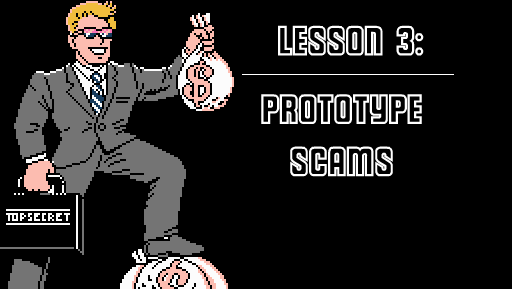
Not everything
is rosy in Prototype Land. Just as there are forgeries of other
valuable items, everything from shipwreck coins to Monets, unfortunately,
NES prototype scams are aplenty, too.
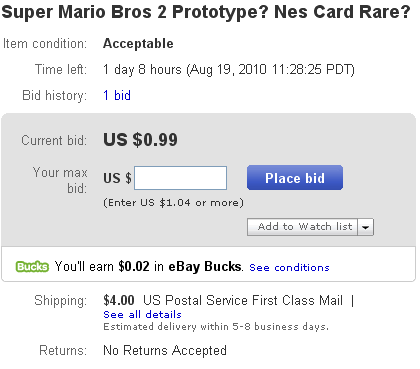
VIEW
AUCTION
This first
example is more common than you might think: a mysterious "prototype"
of a much-beloved game missing its cartridge. No real information
is given, only lots of unanswered questions.
Taken from
the item description:
  Up
for auction is something a little beyond my knowledge. I had purchased
a NES M-82 which is a display unit that was setup in reatil [sic]
stores. Anyways along with the unit i [sic] got a box of items
that were included with the system. In it was a card of sorts
that said "Mario 2 TEST". It was written on masking
tape. I don;'t [sic] even know how to test it or if it works or
what it can possibly be. I I [sic] don;t [sic] know if it is even
worth anything at this point. I no longer want it so it's up for
auction. The masking tape was barely adheisive [sic] and was ripped
so i [sic] threw it away. Up for auction is this card. Up
for auction is something a little beyond my knowledge. I had purchased
a NES M-82 which is a display unit that was setup in reatil [sic]
stores. Anyways along with the unit i [sic] got a box of items
that were included with the system. In it was a card of sorts
that said "Mario 2 TEST". It was written on masking
tape. I don;'t [sic] even know how to test it or if it works or
what it can possibly be. I I [sic] don;t [sic] know if it is even
worth anything at this point. I no longer want it so it's up for
auction. The masking tape was barely adheisive [sic] and was ripped
so i [sic] threw it away. Up for auction is this card. 
Notice the
use of question marks in the auction's title. It's a genuine concern
whenever a seller has to ask what he or she is selling. That this
particular seller understands the basic concept of a game prototype,
supposedly buys something as niche as an NES M-82 (an NES demo
machine used in retail stores for customers to try out new games),
and yet doesn't know how to insert the game into a system to try
it out, leads me to believe that they know exactly what they have
here and are attempting to fool unsuspecting bidders. A piece
of masking tape placed over a common Super Mario Bros. 2
PCB taken out of its cartridge does not make this a prototype.
A search of BootGod's database
will give you a photo of the released Super Mario Bros. 2
PCB for comparison.
I wrote about
MROM prototypes in an earlier section, but it bears repeating:
My personal recommendation to you is that
any game advertised as a prototype that does not contain at least
one EPROM should be avoided unless solid provenance is given.
For your information,
this "Mario 2 Test Card" had four different bidders
by the time the auction had ended. Two of them sniped at the last
minute.
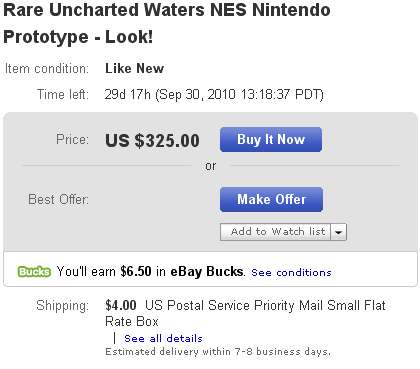
VIEW
AUCTION
Here is a
so-called "prototype" in a cartridge missing its label.
Taken from
item description:
  Rare
Uncharted Waters Prototype Nintendo NES Cartridge. This
game was released in 1991 by KOEI. What I have up for sale here
is a prototype copy of this game. I've had this cart since 2000.
The person I got it from said it was a copy sent to magazines
for review. I'm not sure if that's true or not, but here is what
I do know about the game: Rare
Uncharted Waters Prototype Nintendo NES Cartridge. This
game was released in 1991 by KOEI. What I have up for sale here
is a prototype copy of this game. I've had this cart since 2000.
The person I got it from said it was a copy sent to magazines
for review. I'm not sure if that's true or not, but here is what
I do know about the game:
1. It is
in a cart that appears to never had stickers on it. The surfaces
where the stickers go are clean and smooth.
2. The
cart has no battery, nor do I believe it ever had one, and the
battery leads are not what standard NES battery leads look like
(see second picture for close up of this).
3. The
cart is sealed with standard screws, not the special kind an NES
game released in 1991 would have
been sealed with (the screws look like the ones 5 screw NES carts
are sealed with).
4. The
metal contacts hardly look used at all (aside from the few times
I've played the game).
5. The
case is extra clean.
I've tried
to hunt down info on carts of this type, with no luck. I'm putting
it up on here, and will entertain ANY offers. Please feel free
to ask any questions, and if you need any more pictures also not
a problem! Game Comes in a Plastic Rentel type case. 
When I speak
of the importance of a solid provenance with MROM prototypes,
I do not mean being content with receiving lip service or hearsay
from a seller. Anyone can lie or further spread the lies fed by
previous owners. Anyone can claim that they received a prototype
from someone in the gaming industry or from an old game magazine.
Solid provenance means having the ability to track the lineage
of a prototype so you can contact the previous owner/s if need
be and check the story out and the credentials of the parties
involved.
I decided
to give this seller the benefit of a doubt by sending a message
off and inquiring about the provenance,
specifically asking for the name of the person who had originally
said that the game was sent to magazines for review.
The
next day, he replied:
  I
used to do a lot of trading and selling via usenet groups and
cannot remember the guys name, as it was almost 11 years ago that
I got this. I believe it was either EGM or Gamepro that he said
it was sent to, but once again it was 11 years ago and my memory
is hazy at best. It's been sitting a closet for about 10 years
now at my parents house. I had actually forgotten completely about
it when I moved out, and only recently discovered it doing some
cleaning. I
used to do a lot of trading and selling via usenet groups and
cannot remember the guys name, as it was almost 11 years ago that
I got this. I believe it was either EGM or Gamepro that he said
it was sent to, but once again it was 11 years ago and my memory
is hazy at best. It's been sitting a closet for about 10 years
now at my parents house. I had actually forgotten completely about
it when I moved out, and only recently discovered it doing some
cleaning. 
That says
everything you need to know about the provenance. There is none.
Now to move on to the rest of the item's description.
My thanks
goes out to this seller for numerically listing his arguments.
This will make my debunking of each one much more neat and orderly.
  1.
It is in a cart that appears to never had stickers on it. The
surfaces where the stickers go are clean and smooth. 1.
It is in a cart that appears to never had stickers on it. The
surfaces where the stickers go are clean and smooth. 
1. With a
little Goo Gone and elbow grease, one would be hard pressed to
tell whether a cart previously had a label affixed to it or not.
Besides, not having a label doesn't make this a prototype as many
prototypes come with labels (some even with labels from other
games in re-used carts!).
  2.
The cart has no battery, nor do I believe it ever had one, and
the battery leads are not what standard NES battery leads look
like (see second picture for close up of
this). 2.
The cart has no battery, nor do I believe it ever had one, and
the battery leads are not what standard NES battery leads look
like (see second picture for close up of
this). 
2. Another
visit to BootGod's database
will reveal that the PCBs match. To make this game look a bit
different, it appears as if someone tore
off the battery compartment. Congrats to whoever destroyed
this game in the name of money so now you can't even save your
progress! Hardware vandalism does not make this a prototype. It
only makes Mario cry in his bowl of spaghetti.
  3.
The cart is sealed with standard screws, not the special kind
an NES game released in 1991 would have
been sealed with (the screws look like the ones 5 screw NES carts
are sealed with). 3.
The cart is sealed with standard screws, not the special kind
an NES game released in 1991 would have
been sealed with (the screws look like the ones 5 screw NES carts
are sealed with). 
3. Anyone
with a 3.88MM screwbit can remove a cart's screws and replace
them with another type. Different screws do not make this a prototype.
  4.
The metal contacts hardly look used at all (aside from the few
times I've played the game). 4.
The metal contacts hardly look used at all (aside from the few
times I've played the game). 
4. Now that's
really stretching it. Prototypes can look new or abused, played
with or never played. Its condition does not make this a prototype.
  5.
The case is extra clean. 5.
The case is extra clean. 
5. As are
my minty fresh teeth. They aren't Nintendo prototypes, either.
Unfortunately,
someone who didn't read this page used the buy-it-now and bought
this obvious fake.
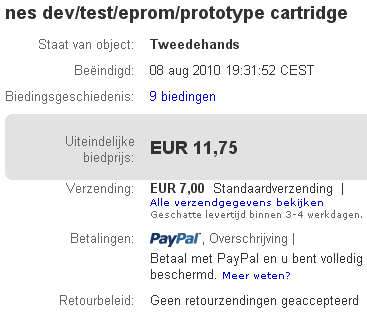
VIEW
AUCTION
This next
example is one of the trickier auctions I have seen.
Taken from
the item description:
  Nintendo
dev/test/prototype/eprom nes cart whatever you want to call it. Nintendo
dev/test/prototype/eprom nes cart whatever you want to call it.
I
found this with other nes carts in a lot at a market (in a wet
box) Yikkes [sic].
On
the cart is the game rescue the embassy mission.Only its [sic]
called hostages in stead [sic] of rescue.The game plays sometimes
great ,another time with glitches. 
The first
concern is with the messiness in the auction
photo. It appears as if the seller threw pieces of torn tissue
all over to obscure the PCB, perhaps even to make it appear as
if he were protecting the EPROMs from the camera's flash. The
life lesson for today is lots of torn tissue spread everywhere
almost always signifies something shady is going down. Just ask
Pee-wee Herman.
There are,
in fact, EPROMs on the PCB, but EPROMs do not determine authenticity
alone—they can be found on something as worthless as a pirated
cart. This is a worthless pirate cart. If the PCB in a prototype
of a game officially licensed by Nintendo does not contain a Nintendo
copyright on it, then it is not authentic. Simple as that.
Of course,
like many things prototype-related, it is never as simple as that.
In this final example, you will see why EPROMs on official Nintendo
PCBs may not be legit prototypes, either.
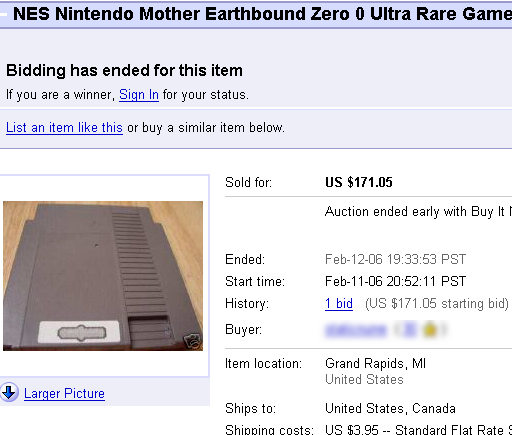
VIEW
AUCTION
The rise in
NES reproductions have EPROMs showing up everywhere these days,
including on Nintendo copyrighted PCBs. Donor carts of various
licensed games are sent to sites like NES
Reproductions where they are fashioned with EPROMs, some solder
and wires, and become virtually any game desired by the customer.
When NES reproduction
makers offer their services to allow NES players to experience
unreleased games and game hacks right on their systems, they have
no control over what happens to their work after a cart is made,
mailed out, and received by a customer.
To discourage
potential scammers, Leon, who runs NES
Reproductions, places the price of each reproduction and his
site's URL inside of every reproduction he makes.
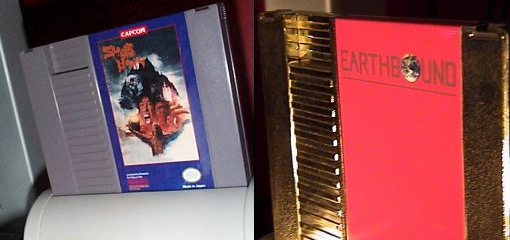
  The
labels on these Sweet Home and Earthbound
reproductions were printed at 2400dpi using an industrial color
laser printer and then laminated, making them look like the real
deal. The
labels on these Sweet Home and Earthbound
reproductions were printed at 2400dpi using an industrial color
laser printer and then laminated, making them look like the real
deal. 
Earthbound
reproductions advertised as genuine prototypes seem to pop up
more than any of the others, but virtually any ROM image you can
find online (including ROMs of prototypes) could potentially be
turned into a reproduction. You should be suspicious of any cart
advertised as a prototype (especially of an unreleased game) that
has a professional label and looks brand new. Furthermore, although
there have been cases of prototypes having a box and manual, know
that this is very rare. Some repro makers create such pieces to
"complete" the look of their reproductions, so be on
the look out for not just faked carts, but faked boxes and manuals,
too. Just as you won't find a real Gucci bag being sold on the
street corner for a fraction of what it's worth, be suspicious
of prototypes with very low Buy-It-Now prices. Many scam auctions
have a Buy-It-Now to ensure a quick sale before the listing is
reported and pulled by eBay. If the price is too good to be true,
it probably is.
Proceed with
caution when it comes to any prototype before buying or bidding,
and always inquire about the provenance. If buying on a messageboard,
ask the seller for eBay feedback, and track their previous sale
posts if they have any. Ask yourself: Is this person an established
member of the gaming community? Does he or she run or contribute
to an established web site? Do veteran members find this person
to be trustworthy? This all might be common sense to some, but
the point remains to do your homework first in order to avoid
the headaches and heartaches later.
Once you've
secured a real prototype of your own, read the next section on
why you should begin to think about preserving it electronically.

|

